#How To Start An Activewear Business
Explore tagged Tumblr posts
Text
How To Start An Activewear Line
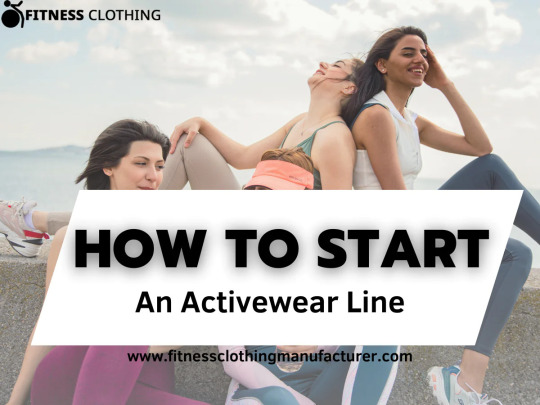
Visit https://www.fitnessclothingmanufacturer.com/our-knowledge/how-to-start-an-activewear-line/ to gain knowledge about starting of activewear business from creating distinctive workout wear to locating trustworthy manufacturers, this comprehensive guide by Fitness Clothing has it all.
#How To Start An Activewear Brand#How To Start An Activewear clothing line#how to start a activewear clothing line#how to start an activewear business#how to start an activewear line#Activewear Clothing Manufacturers#Activewear Fashion#Activewear Fashion Trends#Activewear Industry#Activewear Market Growth#Activewear News#Activewear Trends#Athletic Apparel Industry#clothing line
0 notes
Text
How To Start An Activewear Line
How To Start An Activewear Line - Complete Guide - From Business Plan To Licensing - We Cover It All - Click To Read!
#How To Start A Activewear Clothing Line#How To Start An Activewear Brand#How To Start An Activewear Business#How To Start An Activewear Clothing Line#How To Start An Activewear Line
0 notes
Text
Establish A Yoga Clothing Line
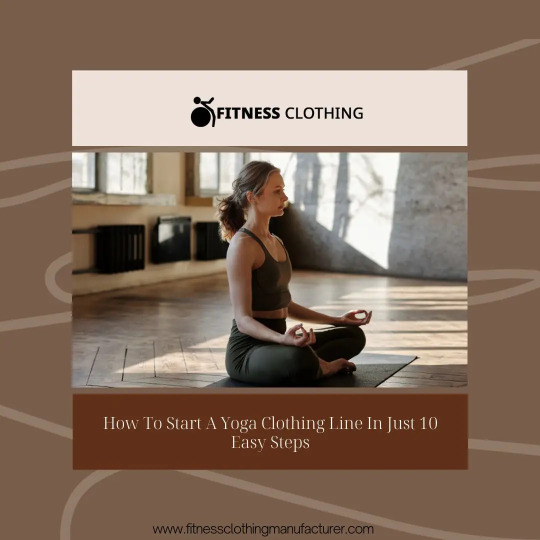
Find out how to launch a line of yoga clothes. To make your yoga apparel business lucrative, adhere to these 10 steps. Read the blog at https://www.fitnessclothingmanufacturer.com/our-knowledge/guide-how-to-start-a-yoga-clothing-line/
#10 steps#Custom Yoga Wear#guide#how to start a Yoga Clothing Line#start a yoga clothing brand#start a yoga clothing business#start a Yoga Clothing Line#Wholesale Yoga Apparel#wholesale yoga clothes#Yoga Clothing Line#yoga clothing manufacturers#Activewear Fashion#clothing line#Fitness clothing business#Fitness Clothing Trends#Yoga Clothing Manufacturer#Yoga Clothing Tips
0 notes
Text
For the Hell of it 3 - Definitely Just Friends

Character: Jason Todd x civilian! Fem!oc
Rating and Warnings: G, no warnings
Word Count: 1,219
Summary: She and Jason take her dog for a walk and talk about how they're definitely not going to get into a relationship, nu-uh.
Masterlist
-------
The third time was on purpose. So were the fourth, and fifth.
Jason had been messaging Andy for the last month, more than he had ever texted anyone outside of the vigilante scene since coming back from the dead.
Sometimes he met her at the college library when she had essays to write and he had case work that could be done in public and neither one wanted to be stuck at home. He made annoying orders at the cafe she worked at on weekends, and she made him terrible coffee in return. Conversation drifted from their shared tastes in books, to food, to travel, to whatever came into their heads.
It was all going well until a fear took root in Jason.
He had no business getting into a relationship. For so many reasons. Gotham was its usual unhinged and dangerous self, and the Red Hood played a vital part in its defense. It would be irresponsible to go dragging some innocent into this life. He couldn’t. He was self aware enough to know vigilantism had made him a paranoid mess, and he wasn’t going to make that anyone else’s problem. And he’d seen how the others started taking only safe bets when they had someone to come home to. He wasn’t going to start playing it safe now, not with so many people counting on him.
Not that he and Andy were dating. But it made him nervous when he found himself flirting, or laughing with her just a little too hard. Thinking about her in idle moments on patrol. Idle moments.. Not on patrol.
Andy was fun. She was beautiful and thoughtful and she didn’t see a ghost when she looked at him.
He couldn’t string her along. It wasn’t fair.
Unless of course she didn’t even want him, in which case he was making a damn fool of himself for nothing.
They were meeting up at the dog park at Too Fucking Early o’clock. She was more fond of mornings than him. Her dog Marlow needed a walk, and they were going to stroll down to the good taco truck for lunch. That wasn’t too intimate. It was lunch, anyone could get lunch.
He got there first, wearing dark glasses and squinting resentfully at the bright winter sun that was cutting through the usual diffusing layer of smog. He casually surveyed the others walking around. Crime Alley looked better by day. He didn’t even spot many hidden weapons. There were some young kids squealing on the grass, and a few people jogging in pairs. A fair few people in different uniforms smoked under shop awnings and there was a line for the coffee truck. Poison Ivy had done some light vandalism on the park a year ago but they had it in hand now and nobody had been eaten by the bushes in months. It was downright pleasant.
“Marlow!” Andy’s voice called.
Jason turned and was immediately confronted with soulful black eyes in a large grey snout staring intently at him. The wiry haired dog the snout was attached to came up to Jason’s hip. His mouth split into a wide smile and he presented a hand for him to sniff. Marlow inspected his offering thoroughly. Then he presented his head for pats, bumping his face at Jason's hand.
“Who’s a good boy, hm?” Jason crouched down to rub his sides. “Ready for your walk? No, no licking my face, come on.”
“If the face isn’t for licking, why is it within licking range? Checkmate, human,” Andy said.
Jason smiled up at her. She was dressed in activewear, red and black tights hugging her shapely legs and hips before they were hidden beneath a thick grey hoodie. Her hair was up in a high bun. She grinned back at him, as blinding as the sunlight.
He swallowed and looked back at Marlow. He got his face licked. She laughed at him.
He made a face and stood up. “I had no idea he was so big. Irish wolfhound, huh?”
“Yeah. I didn’t know what he was when I found him as a puppy.” They started walking together along the dirt paths. “My friend who was totally going to get into vet school any day now said he was an Irish terrier.”
Jason snorted.
“How are things with you?”
“Alright. Work’s keeping me busy and Mrs Nikolaou on seventh street gave me a half sheet tray of Moussaka the other day,” he said. He had told her he was a contractor in private security, which in Gotham wasn’t necessarily a criminal activity, it did not invite follow-up questions. It was easier than maintaining an elaborate string of lies, and unlike Bruce he couldn’t get away with telling everyone he got hurt playing polo.
Andy’s eyebrows spiked. “A half-? What is it with little old ladies adopting you? Where’s my moussaka, is what I’d like to know.”
“I guess you’re just not as cute as me.”
“Impossible. I’m fucking adorable.”
He opened his mouth to agree, and then thought better of it. “Marlow’s about to eat duck poo.”
“Marlow!”
They reached the taco truck, which had a line in front of it to his disappointment. It never had a line at 2AM. It smelled amazing though, and they lined up eagerly. Marlow whined very convincingly but he’d already had his lunch.
They got their orders and sat on a low stone wall to eat.
Strands of Andy’s hair had come loose in the wind, and were at risk of getting stuck in her taco. She kept whipping her hair to try and flick it away, since both her hands were dripping salsa. Jason reached over to brush the hair from her face. She looked up at him and blushed. He tucked the hair behind her ear and grinned at her flustered look. She elbowed him in the stomach and stole one of his corn chips.
Then he got skittish and dedicated his attention back to his lunch. Marlow curled up at their feet, keeping a wary eye on passersby. Andy finished hers first and scrubbed at her hands with a napkin.
She cleared her throat. “Hey.”
“What?”
A silence stretched between them. He glanced at her warily.
“I don’t want to make things weird, but, uh. I’ve been meaning to say.” She stared at her hands in her lap. “I’m not looking for anything romantic at the moment. If that was what you were looking for. It’s not that I don’t like you, I just had a bad break up a while ago and I can’t- I’m not- um.”
Relief and crushing disappointment filled him. He chose to lean into the relief.
“I’m not looking for anything more either,” he said and bumped her shoulder.
She let out a breath of relief and looked up at him. “We can be friends, right?”
“Yeah.” He ran his hands through his hair and coughed a laugh. “I was actually trying to figure out how to ask you the same.”
“Yeah? Bad break up too?”
“Na. Just… not in the right place for it.”
Her shoulders relaxed and he did too. The distance he had been trying to maintain between them fell away. It was safe to get close to her now, because he knew it wasn’t going to lead to anything.
Next >>
#Jason is Very Good at Feelings Oh Yes#jason todd#jason todd x fem!reader#jason todd x oc#jason todd x reader#red hood x oc#slow burn#slice of life#fluff#my fanfic#For the Hell of It#red hood
57 notes
·
View notes
Text
How to Build a Capsule Wardrobe for Effortless Style
A capsule wardrobe is a curated collection of versatile, timeless clothing pieces that work well together, making dressing simple and stylish. Building one helps minimize decision fatigue, save money, and create a sustainable approach to fashion. Here’s how to create your own capsule wardrobe.
Start with Neutral Basics Choose foundational pieces in neutral colors like black, white, gray, navy, and beige. Items like a white button-down shirt, black trousers, and a beige trench coat form the backbone of a capsule wardrobe and can be easily styled for various occasions.
Invest in Quality Over Quantity Focus on high-quality pieces that last, even if they cost more upfront. Look for durable fabrics and classic cuts that won’t go out of style. Think tailored blazers, cashmere sweaters, and leather boots.
Pick Versatile Items Every piece in your capsule wardrobe should serve multiple purposes. For example, a black dress can work for a business meeting, a casual outing, or a formal dinner, depending on how it’s styled.
Stick to a Cohesive Color Palette Choose a color palette with a mix of neutrals and a few accent colors that you love and that complement your skin tone. This ensures all the items in your wardrobe can be mixed and matched effortlessly.
Focus on Seasonal Adjustments Tailor your capsule wardrobe to the current season. For summer, include lightweight fabrics and breezy silhouettes. For winter, add warm coats, boots, and layers. Rotate items in and out of your wardrobe as the seasons change.
Include Key Categories Your capsule wardrobe should cover all aspects of your lifestyle. Include workwear, casual outfits, evening wear, and activewear. Ensure each category has just enough options to suit your needs without overcrowding your closet.
Don’t Forget Accessories Accessories can transform a simple outfit. Add a structured handbag, classic jewelry, and versatile shoes to your capsule collection. Scarves, belts, and hats are also great for elevating your look.
Edit Regularly Reassess your capsule wardrobe every few months. Remove items that no longer fit, suit your style, or get regular use. Replace them with pieces that align with your needs and preferences.
Sustainability Is Key Building a capsule wardrobe supports sustainable fashion practices by encouraging thoughtful purchases and reducing waste. Look for eco-friendly brands or consider secondhand shopping for unique, quality items.
Confidence in Simplicity A capsule wardrobe allows you to focus on quality and style without overwhelming choices. When each piece feels intentional, getting dressed becomes a breeze, and your style feels effortless.
Conclusion Creating a capsule wardrobe is an investment in simplicity and style. By focusing on versatile, timeless pieces and sticking to a cohesive palette, you can create a wardrobe that serves all your needs. Start small, and watch your wardrobe become a reflection of your best self.
#womensfashion#fashion#fashion trends#womenswear#style#timelessfashion#styletips#CapsuleWardrobe#SustainableFashion#MinimalistStyle#TimelessFashion#WardrobeGoals#ChicAndEffortless#StyleSimplified#WardrobeEssentials#FashionTips#EffortlessStyle
4 notes
·
View notes
Text
Wilmer Valderrama, the 44-year-old actor best known for roles such as Fez in the sitcom “That ‘70s Show” and Special Agent Nicholas Torres on the drama series “NCIS,” has immersed himself into the activewear business.
The actor, entrepreneur, activist and fitness enthusiast has introduced a new active lifestyle brand for women and men called E.P.U., which stands for E Pluribus Unum, which is Latin for “out of many, one.”
“I Iove the fashion industry and it’s something that I really have been paying attention to, and have been so fascinated by the people who create fashion,” Valderrama said in a telephone interview Friday.
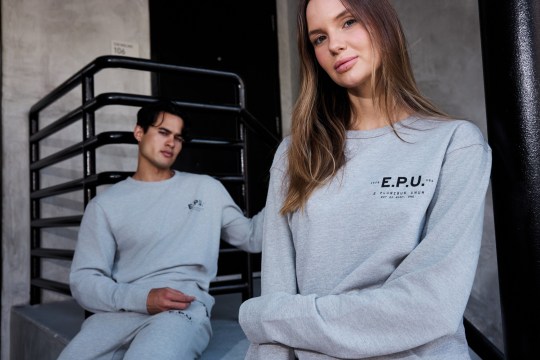
The collection features unisex T-shirts, tanks, crew neck sweaters, sweatpants and sweatshirts, along with men’s and women’s hoodies and joggers and women’s crop T-shirts and tanks.
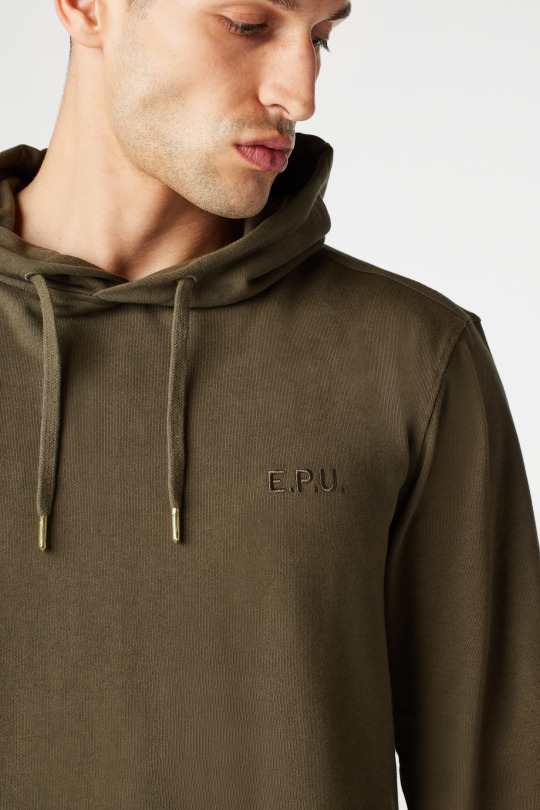
Sizes range from XS to 2XL, with prices going from $25 to $75. The garments are crafted from 100 percent French terry cotton. The socks, duffel, unisex T-shirt, unisex, tanks, and women’s crop T-shirt are all made in the U.S., while the rest is made in Vietnam and India.
E.P.U. has forged a direct partnership with the USO (United Service Organizations) with a portion of sales benefiting their mission of strengthening the well-being of service members and their families. Valderrama, who is a global ambassador for USO, has been on more than 45 USO tours around the world and his time with the troops inspired him to give back to the men and women who serve to protect the country — and the people they leave at home.
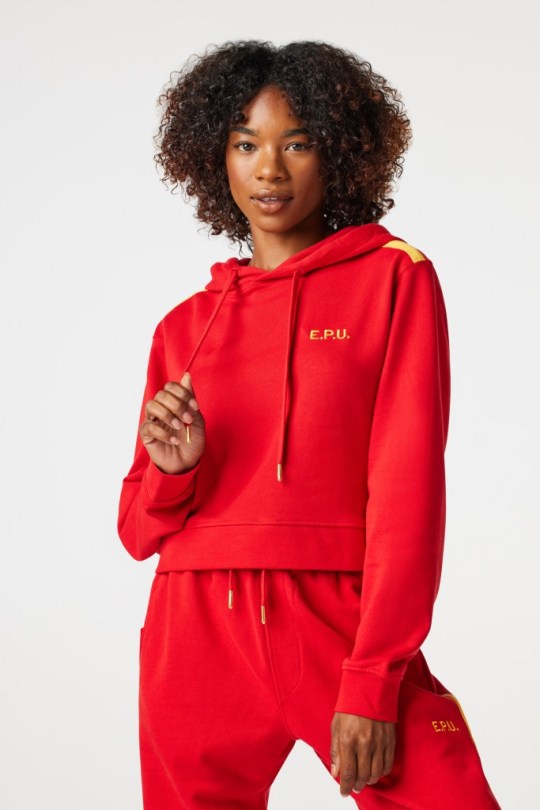
Valderrama said he’s no stranger to the fashion industry. About 10 years ago he was involved in a casual brand for two years called Calavena, which sold in stores such as Saks, Kitson and Barneys. The brand no longer exists.
This time he decided to get into active sportswear for several reasons. First, he realized early on in his career that fitness was something that “not only helped the mental strengthening of the ups and downs of the industry,” but allowed him to look ahead to what roles I wanted to play next. “From Fez and having to transform into a person who could play a cop, it’s part of the transforming process,” he said.
In that journey, he created the hashtag #MyHouraDay, where he would do something active and share it on social media. His followers around the globe started giving their own answers such as “Going for a run,” or “Going for a Swim.”
Further, Valderrama has been inspired by athletes such as cross trainer Mat Fraser and snowboarder and skateboarder Shaun White, who are friends of his. “We’re always talking about mental strengthening, and when you’re out there trying to be number one, what is that mentality?” Valderrama said.
As a global ambassador to USO, Valderrama will bring friends along, talk to the troops and design and host big stage performances with comedians, musicians and DJs. “I’ve been to almost every base around the world. I’ve been to Iraq, Afghanistan, [South] Korea, Germany, Lithuania, you name it, I’ve been at that base,” he said. He began realizing the commonality of the military and what he loves so much.
“Part of their every day is how much they prioritize fitness. Fitness was an extension of their daily routines,” he said. He said he made it part of what he does professionally. “My workouts weren’t negotiable, they weren’t hobbies. [At] 4:30 in the morning, I get up and I’m going to the gym, and then I go to work. It’s part of my workflow. That mentality started creating this mental strengthening that I was not expecting. I always had the bug to go back to fashion. And all of a sudden, I was like, ‘What if?’”
He believed that he could take everything he learned from traveling the world with the military, and the inspiration from his athlete friends to create a brand that infused that kind of community for mental strengthening. Inspired by retro fashion from the 1950s and 1960s and Double RL hoodies and sweatpants, he felt he could create a brand that looked cool and functioned well. They designed the looks to be worn to the gym for a boxing workout or cross-fit training, as well as great travel outfits and clothes that can slip off easily for the pool.
Since today’s generation likes to discover brands on their own, he is selling E.P.U. through an online store, epuhq.com, as well as Instagram and Facebook.
One of his main objectives is to build a community. By donating part of the proceeds to USO, he’d like to be part of building USO Centers around the world and creating programs for veterans and their families. He pointed out that USO is a nonprofit and not government-supported, so it relies on donations.
“This is very much a passion project of mine, and I want to be as bold as possible in supporting these programs. And then the big thing is we build mental strengthening facilities,” he said.
Valderrama, who owns his Los Angeles-based company 100 percent, said he’d eventually like to launch accessories, socks, gloves to work out in, shoes, water-resistant products, weighted-vests and his own equipment.
Asked how he finds the time to run this business, while pursuing an acting career, he said, “There’s always time. If you have something in front of you that’s a priority, the schedule somehow molds into a place that you also have time for it. I have literally daily calls on this. We have photo shoots.…We have tons of community-building content around this,” he said.
“It’s a big undertaking, when they say cut, I start making calls,” Valderrama said. So far, he’s working with eight or nine full-time people in digital, social media and distribution.

Valderrama declined to divulge how much volume he anticipates he’ll do in the first year. “We’re hoping that we sell out very quickly and go right into the next phase. The internal testing that we’ve done has been received incredibly. People love how simple it is,” he said. He anticipates the tracksuits will be a bestseller.
The collection’s color palette is the official colors of the different branches of the military such as red and yellow for the U.S. Marines, green for the U.S. Army and blue for the U.S. Air Force.
Valderamma said he never got a chance to serve in any of these military branches since he got his first big break in TV when he was 18 years old.
He recalled that he became interested in USO years ago when he was walking through an airport and two members of the military came up to him and asked to speak to him. They said that after a long day of doing what they do, they trade “That ‘70s Show” DVDs like they’re baseball cards. “’And we laugh. It really helps and thank you,’” they told him. Valderrama immediately called his agent and said he’d like to show up at their bases. “In two seconds, they sent me out on a USO tour,” he said.
For the collection, he worked with “a design guru who helped scramble what was in his head,” and his fiancée, Amanda Pacheco, who was their fit model and gave suggestions on the women’s fit. To promote the brand, he plans community workouts to show who’s supporting the brand and what the brand is physically doing in real time.
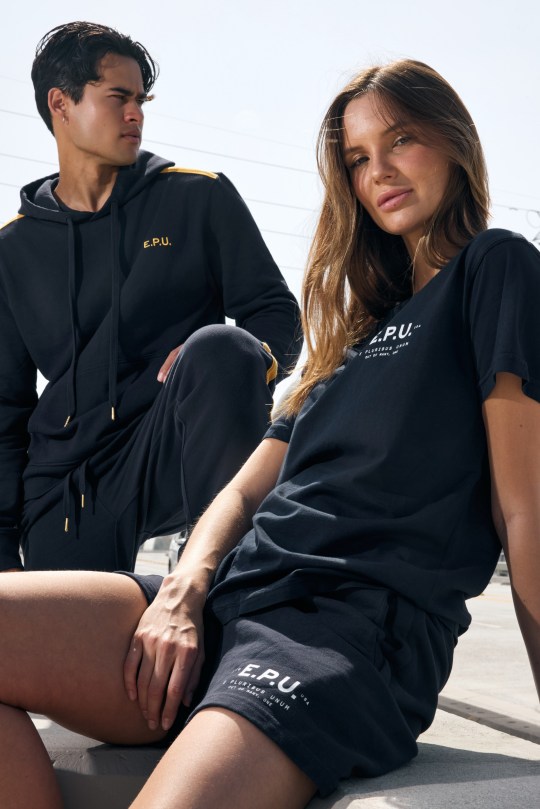
Valderrama was born in Miami but grew up in Venezuela until the age of 13 or 14, when his family moved back to the U.S. and settled in Los Angeles. His father is Venezuelan and his mother is Colombian.
Next week, he will start taping the 22nd season of “NCIS,” which averages 6.5 million to 7 million viewers live every Monday night on Paramount+ and has about 12 million to 13 million viewers overall every week, he said. Valderrama’s next project is a “Zorro” adaptation for Disney, which is in development and he stars and serves as executive producer.
The actor has also written his first book, a memoir entitled “An American Story: Everyone’s Invited,” (HarperCollins) which will be published Sept. 17. “The memoir is a tribute to my family by bringing me to the U.S., and showing me the road and allowing me to walk it. I was able to take the American dream and make it something that belonged to my life,” he said. When he came to the U.S. at around 14 years old, he didn’t know how to speak English. “And by the age of 18, I’m booking ‘That ‘70s Show.'”
3 notes
·
View notes
Text
The State of American Fashion
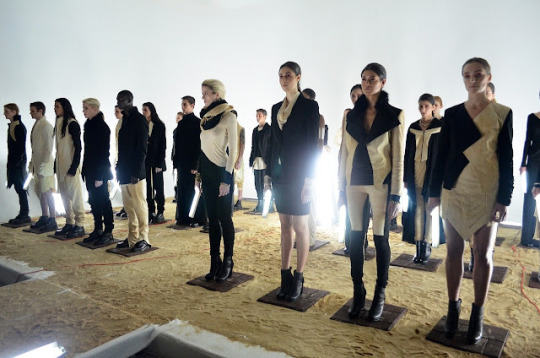
(DISCLAIMER: This article was originally published 1/11/21 on Medium.com, prior to the creation of venustadt.com. As such, my opinions may or may not have altered since the text below was originally written. This article has been re-published here to track my growth as a writer.)
Amid the final days of terrible 2020, there was a row on Twitter about the value of well-known American fashion brand Michael Kors.
“Someone posted a MK purse for Christmas talking about shes spoiled,” Twitter user @Lanazattitude posted Christmas Day. “1st of all MK been played out and thats not being spoiled.”
The lone tweet received around 1,000 replies and over 9,000 quote tweets, sparking a Black Twitter debate about luxury fashion and elitism. But no matter one’s personal opinions on Michael Kors, it is easy to see how quickly people are to undervalue American fashion brands compared to foreign titans like Chanel, Dior, or Balenciaga, to name a few.
The New York fashion scene has never enjoyed the grandeur of its sister fashion hubs London, Milan, or Paris. Many believe that this is due to New York’s lack of large heritage brands. According to former Wall Street Journal fashion and style columnist Christina Binkley, European fashion brands have historical roots in the luxury business due to their origins as artisanal houses. For example, the current French luxury industry owes much to King Louis XIV, who supported French luxury systems until his death in 1715, 61 years before the United States was founded.
This isn’t to say that the U.S. lacks a fashion heritage altogether. Since New York first established itself as a major international fashion force at the 1973 Battle of Versailles fashion show, the American fashion identity has been characterized by its free-spiritedness, prioritizing casual-chic practicality and comfort.
“Americans have a tendency to dress toward the middle,” Deirdre Clemente, fashion historian and curator, told Fashionista’s Maria Bobilo in 2017. “Starting at about the 1930s, dressing like you had money became uncool.”
This American way of “dressing towards the middle” helped make brands like Halston, Donna Karan, and Ralph Lauren influential. This free-spirited attitude can still be seen in American fashion brands today with the rise of athleisure, activewear, and streetwear, which are becoming increasingly popular among international markets. In particular, streetwear has become a powerful force within the industry, as seen with the appointment of Off-White founder Virgil Abloh to artistic director of Louis Vuitton’s menswear in 2018 within the collections of luxury brands like Céline. Brands like Supreme have transformed the way consumers view luxury, reflecting a “bottom-up” trickle of influence in which consumers dictate trends rather than celebrities or traditional fashion industry authorities.
Still, it occasionally feels as if America’s fashion industry is on shaky ground. Even before the pandemic, which forced designers to move shows online or cancel altogether, New York Fashion Week had been labeled a relic that no longer aligned with the way Americans purchased clothing. As fashion trends came and went due to the influence of fast fashion, designers were drained creatively because of the excessive amount of collections produced each year. Foreign buyers and magazine editors often considered skipping New York to avoid the resulting tedious collection from overworked designers.
The ongoing crisis has only made things more uncertain. While stores like Neiman Marcus and J. C. Penney filed for Chapter 11 bankruptcy in May 2020, other brands were forced to contact suppliers to cancel orders, creating financial uncertainty among overseas garment workers. But while specific categories have suffered because of government-mandated lockdowns, others — namely streetwear and athleisure — have only grown stronger. Though the money spent by Americans on clothing has steadily declined since 2018, online sales of leggings, hoodies, and sweatpants have boomed since March, according to Quartz.
Like any other industry, American fashion exists in a constant flux state due to internal and external forces. As COVID-19 cases continue to rise, the fashion industry must brace itself for more inevitable changes and perhaps some much-needed evolution. Perhaps Business of Fashion’s Lauren Sherman said it best in 2019:
“…let’s stop pushing an outmoded model of what an American fashion model should look like and embrace the entrepreneurial, outside spirit at the heart of Americanness, inspiring a new generation to shake things up.”
2 notes
·
View notes
Text
Women’s Clothing Wholesale Vendors for Boutiques
What is Women’s Wholesale Boutique Clothing?
Women’s wholesale boutique clothing refers to purchasing stylish, high-quality apparel in bulk directly from suppliers or manufacturers. This practice allows boutique owners to stock their shelves with trendy and unique designs at lower costs. Whether it’s casual wear, workout clothes, or evening outfits, these clothing pieces cater to a wide range of women’s fashion needs while keeping boutiques competitive in the marketplace.
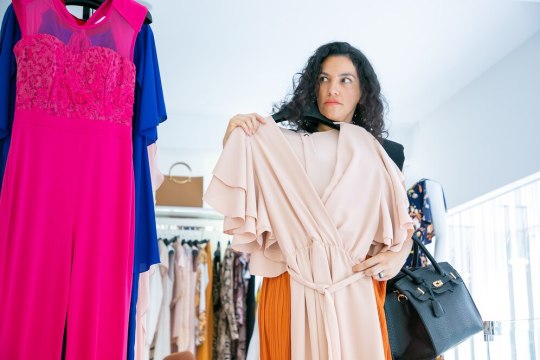
Wholesale suppliers offer a variety of clothing, ranging from fitness apparel to seasonal collections, enabling boutiques to maintain an ever-fresh inventory that attracts customers. Wholesale for boutiques simplifies operations by offering large quantities of clothing at wholesale prices, helping boutiques achieve better profit margins.
How to Find Reliable Wholesale Boutique Clothing Suppliers
Finding the right Women's clothing vendors can be a game-changer for boutique businesses. Here’s how to identify reliable vendors:
Online Marketplaces: Start your search with B2B platforms like Faire, Alibaba, or even local USA-based directories.
Industry Trade Shows: Attend events showcasing apparel manufacturers and wholesale vendors specializing in boutique fashion.
Supplier References: Seek recommendations from other boutique owners or fashion industry insiders.
Direct Manufacturer Partnerships: Partnering directly with women’s apparel wholesale suppliers ensures better quality control and pricing.
Search Locally: Explore nearby women's clothing wholesale suppliers to cut shipping time and costs.
Evaluating the Quality of Suppliers
Quality is crucial for boutique success. To evaluate wholesale women’s clothing vendors:
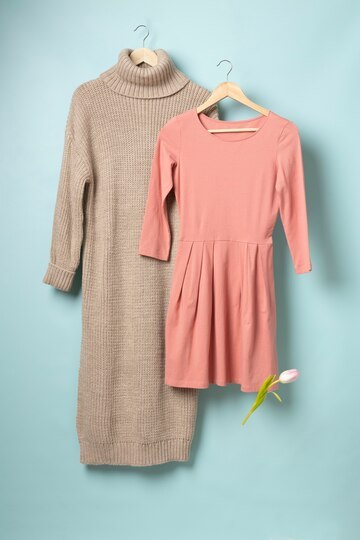
Request Samples: Always order samples to inspect the material, stitching, and fit.
Check Certifications: Ensure suppliers meet ethical and sustainable production standards.
Review Policies: Assess return and refund policies to safeguard your investment.
Read Reviews: Research the vendor’s reputation online by reading reviews and testimonials.
Choosing trusted wholesale women’s clothing vendors ensures that your boutique earns a reputation for quality and style.
What to Look for in a Wholesale Boutique Clothing Supplier
When selecting a women’s apparel wholesale supplier, prioritize the following:
Product Range: Look for a supplier offering diverse styles, including workout clothes and casual wear, to cater to varied customer needs.
Competitive Pricing: Opt for a supplier who balances affordability with quality.
Ethical Practices: Choose vendors who follow ethical manufacturing standards and sustainable practices.
Consistent Inventory: Ensure they have enough stock to meet your boutique’s demands without delays.
Shipping & Logistics: Reliable and timely shipping is vital for boutique operations.
The Benefits of Private Labeling for Boutique Clothing
Private labeling allows boutique owners to create their unique brand identity by customizing clothing designs and adding personal labels. Partnering with custom apparel manufacturers gives boutiques a competitive edge by offering exclusive collections that resonate with their target audience.
Benefits Include:
Brand Recognition: Exclusive designs help establish your boutique’s brand identity.
Higher Profit Margins: Unique designs often justify higher pricing, improving profits.
Customer Loyalty: Exclusive items encourage repeat purchases.
Private labeling transforms your boutique into a brand, making it stand out in a crowded marketplace.
Boutique Fashion Industry Trends
Staying updated with industry trends is crucial for boutique success. Current trends include:
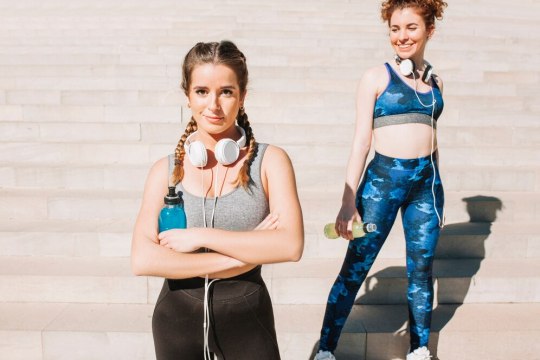
Sustainable Fashion: Fitness clothing suppliers and wholesale vendors now focus on eco-friendly materials.
Activewear Demand: Workout clothes suppliers see increasing demand for fashionable and functional fitness wear.
Personalization: Customers prefer boutiques that offer customized or private-label clothing.
Digital Shopping Experience: Wholesale vendors now prioritize online catalogs and digital partnerships to simplify purchasing.
Boutique owners who adapt to these trends remain competitive and attract fashion-conscious customers.
Conclusion
Finding reliable wholesale women’s clothing vendors is essential for building a successful boutique. Focus on suppliers who prioritize quality, variety, and ethical practices. Evaluate vendors thoroughly, explore private labeling for exclusivity, and stay informed about industry trends to remain ahead in the boutique fashion market. With the right partnerships, your boutique can thrive and grow as a recognized brand in women’s fashion.
#Womens clothing vendors#Workout clothes supplier#wholesale womens clothing vendors#apparel manufacturers#wholesale for boutiques#women's clothing wholesale suppliers#women's apparel wholesale suppliers#Fitness clothing suppliers
0 notes
Text
Unlocking the Potential of Dye Sublimation Printing: A Comprehensive Guide

In the rapidly evolving world of digital printing, dye sublimation printers have become a cornerstone of innovation. Renowned for their ability to produce stunning, high-resolution prints, these printers cater to a wide range of industries, including fashion, home decor, promotional merchandise, and signage. If you’re looking to embrace this transformative technology, this article explores everything you need to know about dye sublimation printing and why it’s the perfect solution for businesses seeking vibrant, durable, and eco-friendly printing results.
Discover the latest advancements in dye sublimation printers to take your printing capabilities to new heights.
What Is Dye Sublimation Printing?
Dye sublimation printing is a digital printing process that uses heat to transfer dye directly into materials like polyester fabrics or specially coated surfaces. Unlike traditional printing methods that apply ink on the surface, sublimation embeds the dye into the material, creating vibrant, long-lasting prints that resist fading, cracking, or peeling.
Whether you’re printing on textiles, mugs, or metal signs, dye sublimation printers ensure impeccable color accuracy and sharpness.
How Does Dye Sublimation Printing Work?
The process is simple yet highly effective:
Design Preparation: Create your design using graphic software.
Printing: Print the design onto a sublimation transfer paper using specialized sublimation inks.
Heat Transfer: Use a heat press to transfer the design from the paper to the substrate.
Sublimation Process: The heat converts the solid dye into gas, embedding it directly into the material’s fibers or coating.
The result? A seamless, high-quality print that’s both vibrant and durable. Learn more about the process with a reliable dye sublimation printer.
Why Choose Dye Sublimation Printing?
Exceptional Color ReproductionDye sublimation printing produces vivid, photo-realistic images with smooth gradients, making it ideal for high-quality applications like photography and artwork reproduction.
Long-Lasting PrintsThe dye fuses with the material, resulting in prints that are resistant to fading, washing, and wear over time.
Versatility Across ApplicationsFrom custom apparel to promotional products, dye sublimation printers work on a wide range of surfaces, including polyester fabrics, ceramics, and coated metals.
Eco-Friendly ProcessUsing water-based inks and minimal waste, dye sublimation is an environmentally conscious printing method.
Quick Turnaround TimesIdeal for on-demand printing, dye sublimation eliminates the need for lengthy setups, making it perfect for small to medium-sized production runs.
Applications of Dye Sublimation Printers
Custom ApparelDesign and print unique t-shirts, jerseys, and activewear with intricate patterns and vibrant colors.
Promotional MerchandiseCreate personalized mugs, mouse pads, phone cases, and keychains for corporate giveaways or retail purposes.
Home DecorAdd a personal touch to curtains, cushions, and wall art, transforming living spaces into creative canvases.
Signage and DisplaysProduce eye-catching banners, flags, and trade show displays that stand out in any setting.
Photography and Art PrintsReproduce stunning artwork and high-quality photographic prints on specialty substrates with a high-performance dye sublimation printer.
Tips for Getting Started with Dye Sublimation Printing
Invest in a High-Quality PrinterOpt for a reliable and efficient dye sublimation printer that aligns with your business needs.
Choose the Right MaterialsEnsure your fabrics are at least 60% polyester or use coated surfaces for non-textile substrates.
Maintain Your PrinterRegular cleaning and maintenance will keep your printer running smoothly and extend its lifespan.
Experiment with DesignsTake advantage of the vibrant color capabilities of dye sublimation to create intricate, detailed designs.
Start SmallBegin with small production runs to understand the process and scale up as you grow confident in your capabilities.
Why Dye Sublimation Printing is Perfect for Today’s Market
With customization and personalization becoming more important to consumers, businesses are turning to dye sublimation printers for their ability to produce one-of-a-kind products. From branded corporate gifts to custom fashion pieces, sublimation printing offers endless opportunities to create unique, high-quality items that resonate with customers.
Additionally, the durability and eco-friendliness of sublimation prints make them a sustainable choice, aligning with the values of environmentally conscious businesses and consumers alike.
Conclusion
Dye sublimation printers are redefining the possibilities in digital printing, offering businesses the tools they need to create stunning, long-lasting, and customizable products. Whether you’re a startup looking to enter the world of personalized merchandise or an established business aiming to expand your product offerings, dye sublimation is a technology worth investing in.Take your printing capabilities to the next level and explore the endless possibilities of dye sublimation printing today.
0 notes
Text
Spring/Summer 2025: A New Era of Sustainable and Inclusive Fashion

Fashion is more than an aesthetic; it’s a mirror of societal shifts, values, and innovation. Spring/Summer 2025 trends reflect the collective call for change—embracing sustainability, inclusivity, and cutting-edge technology. This season isn’t just about what we wear but how fashion shapes our identity and our planet’s future.
1. The Rise of Upcycled Glamour
Who said sustainability can’t be chic? This season, upcycled fabrics take the spotlight. Designers are turning discarded textiles into one-of-a-kind creations that scream high fashion. From patchwork denim jackets to dresses made from repurposed lace, upcycling isn’t just eco-friendly—it’s redefining what luxury means.
By working with recycled fabric suppliers, brands are not only reducing waste but also creating collections that tell a story. Upcycled pieces have a unique charm, blending sustainability with exclusivity.
2. Digital Fashion: Dressing for the Metaverse
The lines between physical and digital worlds are blurring, and fashion is no exception. Virtual wardrobes, augmented reality (AR) try-ons, and NFT-based collections are turning heads in 2025. Imagine wearing an outfit that exists only online but is still the talk of your social feed.
Digital fashion allows brands to reduce production waste while exploring limitless creativity. By leveraging digital design services, they can craft virtual collections that resonate with tech-savvy, eco-conscious audiences.
3. Breaking Boundaries with Gender-Fluid Styles
Fashion is shedding labels and embracing freedom. Gender-fluid designs dominate this season, with unisex silhouettes, neutral palettes, and versatile cuts appealing to everyone. The era of self-expression is here, where style knows no boundaries.
Designing for inclusivity requires innovation and insight. Partnering with gender-fluid fashion consultants can help brands create collections that empower consumers to embrace their individuality.
4. Secondhand Chic: The New Cool
The thrift market is booming, and secondhand shopping is no longer niche—it’s mainstream. From vintage Levi’s to pre-loved luxury handbags, secondhand fashion merges affordability with sustainability. In Spring/Summer 2025, it’s all about mixing thrifted gems with modern staples.
Brands entering the resale market or creating thrift-inspired capsule collections are aligning with this growing demand. Sustainable business strategy services can help brands navigate this shift, offering tailored solutions for incorporating secondhand elements into their models.
5. Smart Fabrics for Smarter Living
Imagine a dress that adjusts to your body temperature or activewear that tracks your hydration levels. Smart fabrics are revolutionizing fashion, merging utility with style. This season, expect to see clothing that’s as functional as it is fashionable.
Innovation in textiles requires collaboration with tech-forward material suppliers. Brands that integrate wearable tech into their designs are not just following trends—they’re shaping the future.
Why Deepwear?
Spring/Summer 2025 is challenging brands to innovate and adapt. Deepwear stands at the intersection of creativity, sustainability, and technology, providing a range of services to help brands succeed. From sourcing sustainable materials to consulting on digital fashion trends, we ensure your collections are ahead of the curve.
Whether you’re exploring upcycled fabrics or diving into virtual fashion, Deepwear bridges the gap between visionary concepts and practical execution. Let us help you lead the fashion industry into a brighter, more responsible future.
Conclusion: Fashion’s Evolution Starts Now
Spring/Summer 2025 isn’t just a season—it’s a movement. From upcycled elegance to digital wardrobes, the trends shaping this season go beyond aesthetics, addressing the urgent need for sustainability and inclusivity. As the world changes, fashion must change with it.
Ready to make an impact? With the right strategies and partnerships, your brand can be at the forefront of this exciting transformation. Let the future inspire you.
#SustainableFashion#SpringSummer2025#UpcycledStyle#DigitalWardrobe#GenderFluidFashion#EcoChic#SmartTextiles#ThriftedTrends
0 notes
Text
Reselling Business Ideas to Kickstart Your Entrepreneurial Journey with Aim Act Grow
The reselling business model is a proven pathway to financial independence and entrepreneurial success. In this article, we’ll explore the best Reselling Business Ideas, practical tips for getting started, and how to leverage modern technology to make your venture thrive. Aim Act Grow is here to guide your journey toward turning your reselling dreams into reality.
Why Choose a Reselling Business?
A reselling business is perfect for those who want to enter the entrepreneurial world with minimal risk and investment. Here are a few reasons why reselling is a great choice:
Low Startup Costs: Reselling requires limited initial investment compared to traditional retail businesses.
Flexible Operations: You can run a reselling business part-time, full-time, or alongside your current job.
Diverse Product Options: Choose products you’re passionate about or those in high demand.
Scalable Opportunities: Start small and expand your offerings as your business grows.
Best Reselling Business Ideas in 2024
1. Clothing and Apparel
Fashion is an ever-growing industry. Start with trendy clothing, activewear, or vintage apparel to cater to specific niches. Utilize platforms like Poshmark, Depop, or Shopify to sell your items.
2. Electronics and Gadgets
Tech enthusiasts are always on the lookout for the latest gadgets or refurbished electronics. Reselling smartphones, laptops, or accessories like headphones and chargers can generate significant profits.
3. Books and Educational Materials
From novels to textbooks, books remain in demand. Source your inventory from clearance sales or secondhand stores and sell them through Amazon or eBay.
4. Home Décor and Furniture
Reselling high-quality furniture or unique home décor items is a lucrative market. Promote your products via Instagram or Etsy to attract design-savvy customers.
5. Beauty and Skincare Products
The beauty industry continues to thrive, with demand for skincare, makeup, and personal care products at an all-time high. Partner with wholesale suppliers to stock authentic, popular items.
6. Vintage and Collectibles
Whether it’s rare coins, vinyl records, or antique furniture, collectors will pay premium prices for unique finds. Reselling vintage items can turn your hobby into a profitable business.
7. Health and Wellness Products
With increasing health awareness, reselling fitness equipment, supplements, or organic products can be highly rewarding.
8. Pet Products
Pet lovers are always looking for unique toys, accessories, and high-quality food for their furry friends. Start a pet-focused reselling store to tap into this loyal customer base.
9. Shoes and Accessories
From branded sneakers to handmade jewelry, shoes and accessories have a wide-ranging audience. Collaborate with suppliers who offer stylish and durable products.
10. Digital Products
E-books, stock photos, and software licenses are examples of digital goods you can resell without worrying about inventory storage or shipping.
How to Start Your Reselling Business
1. Research Your Market
Identify the target audience, current trends, and high-demand products within your niche. Use tools like Google Trends and social media analytics to understand customer preferences.
2. Find Reliable Suppliers
Partner with trustworthy wholesalers or dropshipping providers who offer quality products at competitive prices.
3. Set Up an Online Store
Platforms like Shopify, WooCommerce, or Etsy make it easy to launch your store. Use Aim Act Grow’s expert tips to optimize your e-commerce platform for maximum visibility.
4. Leverage Social Media
Use Instagram, Facebook, and TikTok to showcase your products. Engaging visuals and authentic customer reviews can significantly boost your reach.
5. Provide Excellent Customer Service
Happy customers are your best brand ambassadors. Offer timely responses, hassle-free returns, and consistent quality to build trust.
Scaling Your Reselling Business
Once your business is up and running, consider these strategies to expand your reach and maximize profits:
Automate Operations: Use inventory management software to streamline processes like stock tracking and order fulfillment.
Diversify Products: Expand your offerings by introducing complementary or trending items.
Build a Brand: Develop a strong, unique identity to differentiate your business from competitors.
Run Paid Ads: Invest in targeted advertising on Google, Facebook, or Instagram to drive traffic to your store.
Collaborate with Influencers: Partner with niche influencers to promote your products and reach a wider audience.
Common Challenges in Reselling and How to Overcome Them
Finding Quality Suppliers: Vet suppliers thoroughly by checking reviews and requesting samples.
Managing Inventory: Start small to avoid overstocking or investing in unpopular items.
Standing Out in a Competitive Market: Focus on excellent customer service and unique product offerings.
Success Stories: Inspiration for Your Reselling Journey
1. From Hobby to Business
A young entrepreneur turned her passion for vintage clothing into a thriving online store, generating over $50,000 annually. Her secret? Engaging social media content and excellent customer service.
2. Tech Reseller Extraordinaire
A tech enthusiast began reselling refurbished laptops on eBay. By ensuring quality and offering competitive prices, he built a loyal customer base and doubled his income in two years.
Aim Act Grow: Your Partner in Success
Starting a reselling business is just the beginning. At Aim Act Grow, we provide actionable advice, industry insights, and digital marketing strategies to help entrepreneurs succeed. From crafting SEO-optimized content to building a powerful online presence, we’re committed to your growth.
Explore more entrepreneurial ideas and resources on our website, Aim Act Grow.
Conclusion
The reselling business model offers endless opportunities for budding entrepreneurs. With minimal investment, creative product choices, and a strategic approach, you can turn your passion into profit. Follow the ideas and tips shared here to kickstart your journey with confidence.
Remember, success in reselling comes down to understanding your audience, delivering quality, and consistently evolving with market trends. Let Aim Act Grow be your guiding light as you build your reselling empire!
0 notes
Text
10 Steps To Start An Activewear Brand
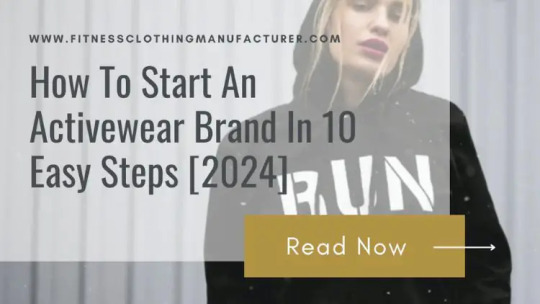
Learn how to start an activewear brand in 10 steps. These steps guides a business owner from market research through product manufacturing to selling the product accordingly to gain business advantage in easy way.
#activewearbusiness#activewearbusinessplan#activewearclothing#Activewearmanufacturers#HowToStartAnActivewearBrand#privatelabelactivewear#StartAnActivewearBrand#startinganactivewearline#ActiveWearTips#ActivewearClothingManufacturers#ActivewearFashion
0 notes
Text
YRC Shares Key Insights on Starting an Activewear Clothing Line: Mastering the Basics for Success - Part 1

YRC explains the basics of launching an activewear line in MENA, highlighting unique market challenges and opportunities in UAE, Saudi Arabia, and Egypt.
Empowering Retail & E-commerce businesses worldwide.”
— Nikhil AgarwalPUNE, MAHARASHTRA, INDIA, October 5, 2024 /EINPresswire.com/ -- Driven by specific requirements of different workouts and physical activities and the need to look fashionable, activewear fashion has gained significant popularity in recent years. However, despite the common reasons explaining the growth of activewear fashion, every market presents a unique story with unique business challenges. Given the favourable demographic factors and widespread adoption of eCommerce, starting and establishing an activewear clothing line in one of the Middle East or MENA countries like the UAE, Saudi Arabia, or Egypt, has attained a challenging stature. In this media release, 𝗿𝗲𝘁𝗮𝗶𝗹 𝗮𝗻𝗱 𝗲𝗖𝗼𝗺𝗺𝗲𝗿𝗰𝗲 𝗰𝗼𝗻𝘀𝘂𝗹𝘁𝗶𝗻𝗴 brand, YourRetailCoach (YRC) sheds light on the basics of starting an activewear clothing line in the region.
Get advise for E-commerce retail business : https://www.yourretailcoach.ae/contact-us/
𝗕𝘂𝘀𝗶𝗻𝗲𝘀𝘀 𝗜𝗱𝗲𝗮 𝗩𝗮𝗹𝗶𝗱𝗮𝘁𝗶𝗼𝗻
An activewear business may sound attractive but as a business idea, it must go through the test of validation. Relevant questions to be asked for critical examination in this case include (but are not limited to):
· Why activewear clothing business? Is there any specific experience or expertise that gives an upper hand or is there a pre-existing presence in a similar line of business? · Does the proposed business cover any market gap? · Does the proposed business fulfil one or more voids in the customer and user journey? · What are the intended value propositions? Can such values bring brand distinction? · Who are the potential customer segments? How can they be defined? · How are the intended value propositions going to be created and delivered? · What is the sense of ease of doing business?
The answer to the above questions may help shed light on previously unrealised or undermined pros and cons associated with the business idea and market and industry conditions. One of the important outcomes of business idea validation is that it provides valuable inputs for 𝗯𝘂𝘀𝗶𝗻𝗲𝘀𝘀 𝗺𝗼𝗱𝗲𝗹 𝗱𝗲𝘃𝗲𝗹𝗼𝗽𝗺𝗲𝗻𝘁 and overall business planning.
𝗦𝗰𝗼𝗽𝗲 𝗼𝗳 𝗟𝗲𝘃𝗲𝗿𝗮𝗴𝗶𝗻𝗴 𝗮𝗻𝗱 𝗜𝗻𝘁𝗲𝗴𝗿𝗮𝘁𝗶𝗼𝗻
Having an existing edge that is relevant to the proposed enterprise could provide competitive advantages if leveraged correctly. For example, having its own commercial space that can be used as a store location saves a significant chunk of operating expenses that otherwise must be incurred. Although as per accounting principles business owners and businesses are two different entities the benefits of this saved expense are tangible. There are also plenty of examples where popular sportspersons have forayed into the realm of fashion and fitness business. Another form of having an existing edge is a prior presence in the same or a similar line of business or profession that could lead to the integration of capabilities. For instance, many retail clothing brands could be seen using their existing network of stores for new product lines. Having such a scope for leveraging and integrating capabilities serves as a strategic advantage. It reduces the operational burden and the initial costs of setting up new distribution channels from scratch.
𝗨𝗻𝗶𝗾𝘂𝗲𝗻𝗲𝘀𝘀 𝗮𝗻𝗱 𝗗𝗶𝗳𝗳𝗶𝗰𝘂𝗹𝘁𝘆 𝗼𝗳 𝗥𝗲𝗽𝗹𝗶𝗰𝗮𝘁𝗶𝗻𝗴
Even though the activewear segment might have turned competitive, there is still immense potential to come up with unique value propositions and brand positioning. Activewear is associated with the sports segment - one that has numerous categories. Each category further has different levels of expertise. For example, the needs of professionals are different from those of beginners or casual hobbyists. It creates a wide gap between needs and price points. Then there is the factor of localisation. Not all sports or sports-related activity preferences are the same everywhere. The presence of necessary infrastructure and services is another vital consideration. If cities like Dubai, Abu Dhabi, Muscat, Riyadh, Kuwait City, Doha, or Cairo (to name a few) are considered, the focus for finding unique values and brand space has to go wider and deeper. As experienced omnichannel consultants, YRC recommends that the factor of ease of replicating a value proposition (by competitors, now or in the near future) should be given due consideration.
𝗩𝗶𝘀𝗶𝗼𝗻 𝗳𝗼𝗿 𝗣𝗿𝗼𝗳𝗶𝘁𝗮𝗯𝗶𝗹𝗶𝘁𝘆
In business planning, profitability is gauged at the time of financial and commercial planning. However, much before that (even before business model development), an entrepreneur should have a clear and logical vision supporting the proposed business to be promisingly profitable or resulting easily in a surplus situation. The use of the words - promising and easily is to emphasise clarity of applied vision. If profitability looks difficult in the plain sight of expert vision, the business idea may be calling for rework. Of course, no business idea is perfect from the beginning but it must show workability in its existing form - however raw it may be. For example, if the idea is to offer jogging suits at affordable rates under a given set of demographics in a given market, there should be no doubt left unaddressed in the business concept that questions its prospects of profitability.
𝗩𝗶𝘀𝗶𝗼𝗻 𝗳𝗼𝗿 𝗚𝗿𝗼𝘄𝘁𝗵 𝗮𝗻𝗱 𝗘𝘅𝗽𝗮𝗻𝘀𝗶𝗼𝗻
Every business idea must be accompanied by potential strategies for its growth and expansion walking into the future. Fortunately, there are some time-tested strategies for striving to achieve growth and expansion in business. For example, market penetration strategy tends to be popular among experienced brands and businesses. These enterprises carry strong knowledge of their products and markets. They heighten their focus on their existing markets with existing product lines. Franchising is another powerful strategy used by reputed brands and businesses to expand in different collaborative styles.
𝗔𝗯𝗼𝘂𝘁 𝗬𝗼𝘂𝗿𝗥𝗲𝘁𝗮𝗶𝗹𝗖𝗼𝗮𝗰𝗵:
YourRetailCoach (YRC) is a boutique retail and eCommerce consulting house with over 10 years of experience in developing and delivering enterprise startup and management solutions. With a scaling international trail, YRC has served 500+ clients in more than 25 verticals with a success ratio of 95%. In activewear 𝗳𝗮𝘀𝗵𝗶𝗼𝗻 𝗯𝘂𝘀𝗶𝗻𝗲𝘀𝘀 𝗰𝗼𝗻𝘀𝘂𝗹𝘁𝗶𝗻𝗴, YRC offers planning and implementation services and solutions for business setup and growth and expansion endeavours.
For expert assistance in activewear 𝗰𝗹𝗼𝘁𝗵𝗶𝗻𝗴 𝗹𝗶𝗻𝗲 𝗯𝘂𝘀𝗶𝗻𝗲𝘀𝘀 𝘀𝗲𝘁-𝘂𝗽 ( https://www.yourretailcoach.ae/fashion-retail ), management, and expansion or to speak to one of YRC’s fashion retail business consultants and Get advise for E-commerce retail business : https://www.yourretailcoach.ae/contact-us/
Rupal Nikhil Agarwal YourRetailCoach +91 98604 26700 [email protected] Visit us on social media: Facebook X LinkedIn YouTube
0 notes
Text
Different Ways To Start An Activewear Brand
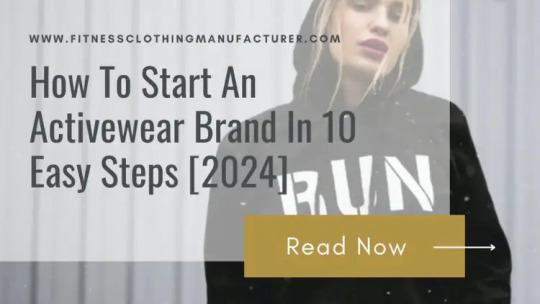
Learn 10 easy steps to initiate an activewear brand with the help of a guide offered by Fitness Clothing. Everything from design and sourcing to marketing and branding is covered in this extensive book. Check out https://www.fitnessclothingmanufacturer.com/our-knowledge/how-to-start-an-activewear-brand-in-10-easy-steps/
#activewear business#activewear business plan#activewear clothing#Activewear manufacturers#How To Start An Activewear Brand#private label activewear#Start An Activewear Brand#starting an activewear line#Active Wear Tips#Activewear Clothing Manufacturers#Activewear Fashion
0 notes
Text
Keep this amazing binder company in business 🙏
before my surgery, my flavnt binder was the best I'd ever had. everyone i know who's tried one is shocked by how comfortable they are and how much they compress. i wore mine almost every day, even in the pool! I'd be devastated if such an incredible resource disappeared from our community. here's the text from their gofundme:
Hi, this is Courtney and Chris Rhodes - owners of Flavnt Streetwear. We founded FLAVNT in 2014, but in 2015, we introduced the world to our concept of a chest binder that came in a range of nude colors, something that made the binder market more inclusive and diverse than it ever was previously. For the past 8 years, we’ve sold our Bareskin Binders and provided a chest binding solution to the queer community that is made by and for trans people.
This year, we decided to reinvest in our product and change manufacturers. We’ve used the same manufacturing team here in Austin for the last 4 years, and while we love and appreciate the work they did, they were unable to scale or meet our deadlines or quality needs. We found another local company - a reputable and inclusive brand in the activewear space and went all-in.
This summer, we went into production, placed an order for a full run of all of our sizes and colors. We paid upwards of $15,000 upfront and were promised binders in stock by October. As of late September, that company stopped responding to our communications. They have completely ghosted us, taking our money, fabric, patterns, and, frankly, leaving us without means to make ends meet along with not having a much-needed product available for this community. We’ve gone by their location and there are eviction notices on the doors, so our chances of getting our money back or product are not looking good. We don’t have the means to get into a drawn-out legal battle - we don’t even have the means to pay our rent for November after these circumstances. So we are asking for your help to pay back the funds we are out including credit card interest and help us pay our rent in the meantime.
Here's even more backstory about FLAVNT over the years:
We started Flavnt with $500 of our own money, oftentimes helping carry the business by paying out of our own pocket, all while donating back into the community. (We've donated over $50,000 to trans individuals for gender-affirming surgeries and to nonprofits.)
For the past 3 years, we haven’t paid ourselves at all because there hasn’t been enough money to cover rising costs and keep our commercial space. We are asking the community to stand behind us and help to carry us through this tough time following a horrendous year.
Last year, we were thrilled to be a part of the Target Pride campaign. We were banking on a huge successful quarter of sales from that, but after a year of designing and working on a collection exclusively for them, Target pulling Pride products from the shelves resulted in tens of thousands of dollars in product never being sold and us not seeing any sales. Following that, we literally had several thousands of dollars stolen from us by two separate accountants. Now this. All we want is to be able to keep making proud apparel and to keep providing representation and aid to our community.
Our Venmo is @flavnt if you'd rather directly donate there. You can also purchase from our site (www.flavnt.com) at any time. We want to keep making things for our community and doing what we love, but we desperately need help. And if you have any resources for dependable manufacturers in Texas or otherwise, please reach out. We are trying to remain positive and find a way to persist, but things have never seemed this bleak. Thank you for your support as always.
0 notes
Text
Cotton Incorporated
Every time we get the opportunity to explore a new business I say it's my favorite place yet. Well...
This study tour might have been my favorite so far. As someone who is incredibly interested in sourcing and textiles, I loved getting to see the inner workings of what my future could look like if I chose to follow this path.
One of the first things I noticed was the building itself. It was nice, clean, and in the elevator going up to the Cotton Inc. offices, there was an advertisement for their "Zero Waste Townhall," which piqued my interest.





Cotton Inc. was founded in 1970 in response to the rising popularity of synthetic fibers, which were starting to encroach on natural fiber's market share. They are considered a not-for-profit, as instead of offering a specific product, they offer research and promotions to sell cotton. We got to visit their consumer marketing office, but their world headquarters are located in North Carolina.
Hearing our speaker, Aubrey, discuss the business was incredibly interesting. She is in fashion forecasting, meaning she does research in order to predict the trends of the future.
The most interesting part for me was the sourcing. Aubret and her coworkers do a lot of travel to different markets like Asia and Europe. The goal is to find pieces that will aid in their forecasting. However, as a cotton-based not-for-profit, they focus on "cotton-rich" fabrics.
Everything they source must follow these rules:
The fabric must contain 50% or above in cotton for activewear
No lower than 95% cotton for denim
80% or above for all other categories
To me, it seems like it would be interesting to have to shop by fiber. I wonder how many items are not bought because they do not meet those requirements.
This was a wonderful experience. Thank you, Cotton Inc.! I hope I can intern with you in the future :)
0 notes